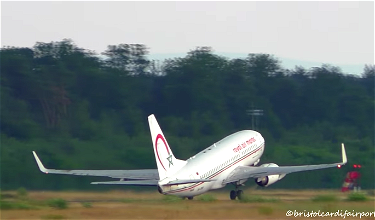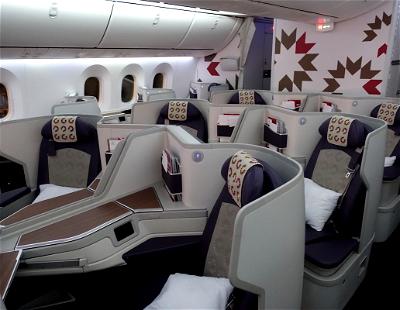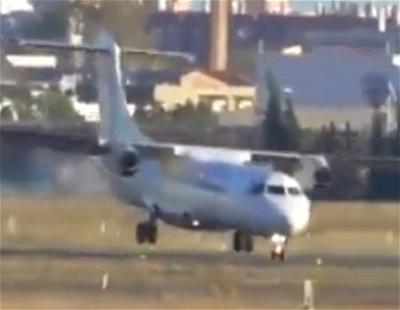Earlier I posted the insane video footage of a Royal Air Maroc 737 struggling to take off at Frankfurt Airport.
In the video you can see a Royal Air Maroc 737-700 lift its nose but struggle to take off. It very briefly gets airborne (which could have led to a stall), but then the pilots bring it back down, continue to accelerate, and then finally take off.
We ultimately don’t know what caused the incident. It could have been that the pilots didn’t use enough flaps. It could have been that the pilots had the takeoff speed wrong. Or it could have been any of a number of other things.
Even if the pilots caused it, their recovery in the incident was excellent, it would seem.
The Aviation Herald covered this incident, including the bizarre explanation that Royal Air Maroc provided of the incident on Twitter, which roughly translates as follows:
“Following dissemination of false information about flight AT-811 of July 23rd, Frankfurt – Casablanca, we wish to clarify that Frankfurt tower advised the captain of our flight in question of possible wake turbulence as result of a simultaneous landing of an A330. As result the captain performed a maneuver to accelerate in order to achieve speeds which permitted safe takeoff.”
This suggests that the pilot intentionally performed the maneuver to avoid wake turbulence.
I’m not an airline pilot, though I showed the video and Royal Air Maroc’s explanation to a friend who’s a 737 captain, and his response was simply “wtf?”
I know I have quite a few readers who are Boeing pilots, so let me throw it out there… is the “almost have a tail strike, then get airborne at stall-worthy speeds, and then get back on the runway to gain enough speed” maneuver something others are familiar with, or is it something only Royal Air Maroc trains their pilots to do?
I understand Royal Air Maroc probably wants to save face here, but it seems like “we’re investigating the incident” may have been a better answer.
Truly a bizarre explanation…




Is somebody gonna get fired or reviewed for this?
This is scary
have you shed light yet on southwests' latest shoddy maintenance record with their latest incident?
or are we quite happy to highlight the world's shortcoming and stop there?
what happened at SWA was no less safer than what happened at RAM.
Its like sticking your toe in the water to see how it feels - Royal Air Maroc was just testing the wake turbulence
P.s. Most explanations are pointing towards multiple pilot errors. I say multiple because whether trim, V speed, or flap, they're all included in checklists!
Just consulted my senior instructor on this one. His first instinct was that the crew likely didn't/forgot to trim the aircraft properly for the CG, and had the configuration too far back(usually the case after a landing). This
caused the nose to pitch up prematurely at low speed. They recognized the issue quick enough and pushed their control wheel down to stablize the aircraft.
The more I think about this the more it...
Just consulted my senior instructor on this one. His first instinct was that the crew likely didn't/forgot to trim the aircraft properly for the CG, and had the configuration too far back(usually the case after a landing). This
caused the nose to pitch up prematurely at low speed. They recognized the issue quick enough and pushed their control wheel down to stablize the aircraft.
The more I think about this the more it makes sense: if this was an issue with incorrect V speed, the PF would've likely kept rotating(under the assumption that he was using the correct speed) or kept a stable pitch up angle until the aircraft becomes airborne- it would be unusual to push the nose completely down and pull it back up again if it was an issue with the incorrect V speed.
The instructor also noted that the argument with wake turbulence is unlikely...
So a few things...there is a number of reasons this could have happened. But before we get to those, let's debunk a few things that have been said here that are incorrect. The flaps are extended although not as much as is usually the case. That does not mean the pilots made an error with flap setting. On an aircraft like the 73G, which has amazing short field performance, it is entirely possible that with...
So a few things...there is a number of reasons this could have happened. But before we get to those, let's debunk a few things that have been said here that are incorrect. The flaps are extended although not as much as is usually the case. That does not mean the pilots made an error with flap setting. On an aircraft like the 73G, which has amazing short field performance, it is entirely possible that with a long runway like FRA 18 and low payload, that Flaps 1 or 2 could have been sufficient.
The flaps also did not extend during the takeoff roll. They were constant. We also don't know that the pilots erred in not aborting the to roll. Depending on whether they had reached V2, they might have been forced to try to wrestle it airborne.
Based on what I am seeing, I would bet on the aircrat having been improperly trimmed (which would make the aircraft pitch up prematurely) or that the crew put an incorrect payload weight into the FMC (again triggering a V2 call too early). As soon as they understood they needed more speed, they lowered the nose and gained enough to get off the ground.
Surely a problem here and clearly pilot error.
Reminds me of a friend on his bike
https://www.youtube.com/watch?v=9hNIX7V21pU
It is possible that someone was in aft lavatory at gate and left a heavy dump than walked to the front row, much lighter at that point. Center of balance thrown off. Nose up, tail just can't get off ground with that weight back there. Plossible.
Make that flap setting and takeoff weight.
I'm going to roll with the cockpit crew having incorrect speed data for their flap setting as my rampant speculation here.
@Donna, that's gotta be it, lol!
Take a look at some more scientific "WAG's" (not wives and girlfiends) on the matter here:
http://www.pprune.org/rumours-news/583458-maroc-737-loss-lift-incident-fra-3.html
I thought the best comment was: "He didn't panic and try and stop, so I reckon he made a good job out of a bad situation, even if they did (maybe) cause that problem in the first place."
Greg
All the arm chair captains that think airplanes takeoff with 'full throttle' make the comments fun to read. Carry on.
Can't tell what engine it's using, but the CFM56 take off is with Flagstaff @5 and at least 85% power with 15-17 degree take off pitch and at least 90% with 18-20 degree take off pitch --- at sea level 15Celsius. ---
Even with only one engine working, it is at least 90% power at V1.
Royal Air Maroc would have been better off just not commenting. Not only does their explanation sound laughable, there is video of the incident too. My guess is that 99.9% of people will take what they say at face value and move on like it was NBD and that's who their PR department is trying to appease. Only us AvGeeks are throwing our hand up going "hang on, say what now?"
The flaps certainly...
Royal Air Maroc would have been better off just not commenting. Not only does their explanation sound laughable, there is video of the incident too. My guess is that 99.9% of people will take what they say at face value and move on like it was NBD and that's who their PR department is trying to appease. Only us AvGeeks are throwing our hand up going "hang on, say what now?"
The flaps certainly don't look extended and the plane actually doesn't seem to accelerate at full throttle; it seems to be stuck in that initial 80% throttle before they throw it to full throttle. You can just listen to the noise of the engines in the video. It doesn't sound like a normal 737 takeoff roll.
Wheelies on takeoff. More fun for the passengers!
I am a pilot but not a 737 pilot. I can't tell for certain in the video though it looks like the flaps may actually be extending during the takeoff roll. So I speculate (and it's pure speculation) that they initially opened the throttle with zero flaps, got a warning horn, then decided to extend them to the takeoff position during the takeoff roll instead of coming to a stop. Then they tried to rotate...
I am a pilot but not a 737 pilot. I can't tell for certain in the video though it looks like the flaps may actually be extending during the takeoff roll. So I speculate (and it's pure speculation) that they initially opened the throttle with zero flaps, got a warning horn, then decided to extend them to the takeoff position during the takeoff roll instead of coming to a stop. Then they tried to rotate at the normal, flaps extended, speed but the wing wasn't generating enough lift at that point. Thankfully the runway was long enough.
Actually, this is a manuver of soft field takeoff. Quickly gain speed with nose up.
@ Endre -- Remember that from my flight training back in the day. But I think a Cessna 172 on a field is a little bit different than a 737 on a long runway. ;)
@lucky. The soft field take off manuver was a small joke. Never less, most of Russian type commercial planes in the 50's 60's 70's were built for soft field take off and landings. That is why the Tu 134 Tu 154 IL 62 etc had tandem or triple carriages (4 or 6 wheels per main gear assembly). Even with 100-200 passengers, they had to practice and execute soft field take offs in many Soviet airfields...
@lucky. The soft field take off manuver was a small joke. Never less, most of Russian type commercial planes in the 50's 60's 70's were built for soft field take off and landings. That is why the Tu 134 Tu 154 IL 62 etc had tandem or triple carriages (4 or 6 wheels per main gear assembly). Even with 100-200 passengers, they had to practice and execute soft field take offs in many Soviet airfields (nose quickly up before true rotation speed). Many of those softfield take offs were very scary from an outside viewer but standard for those pilots who were all Soviet Air Force pilots.
They are damn lucky that tail didn't hit in the back. Wow
For some people, admitting one made a mistake is not seen as something courageous or respectable - it is seen as weak, so it is better to minimize and deny than to take responsibility.
My friend who is a B767 captain pilot said it looked like wake turbulence. He thinks slats were set for takeoff . My discussion with him happened before this report.
*grabs popcorn*